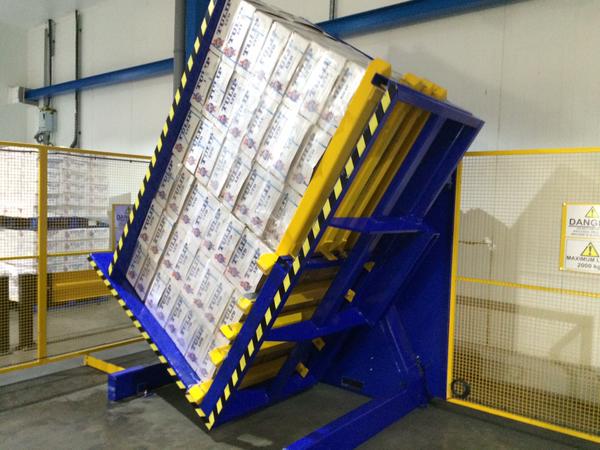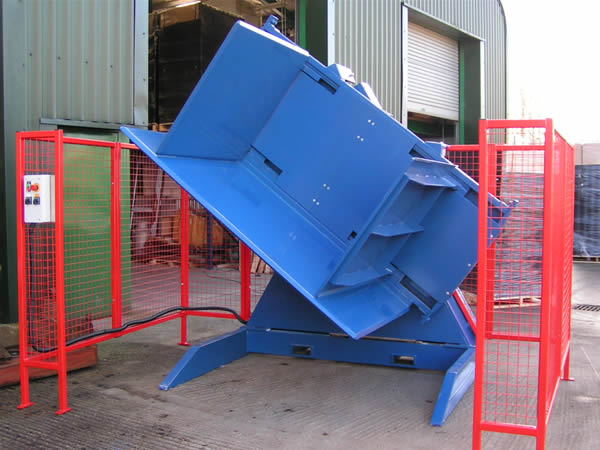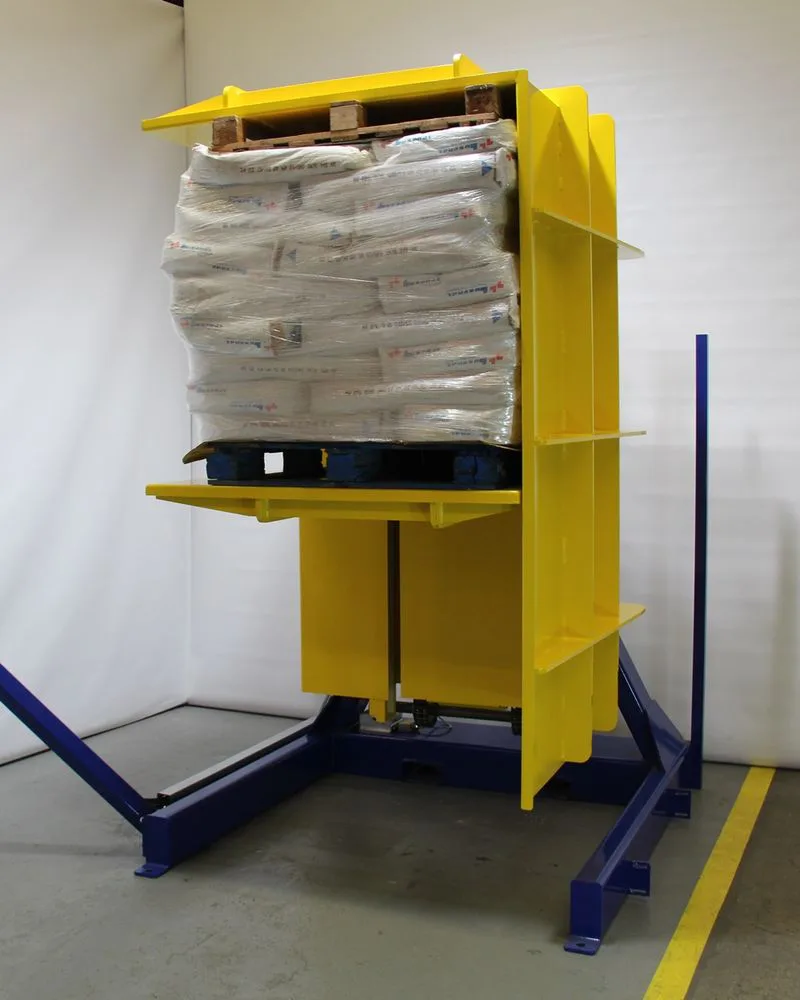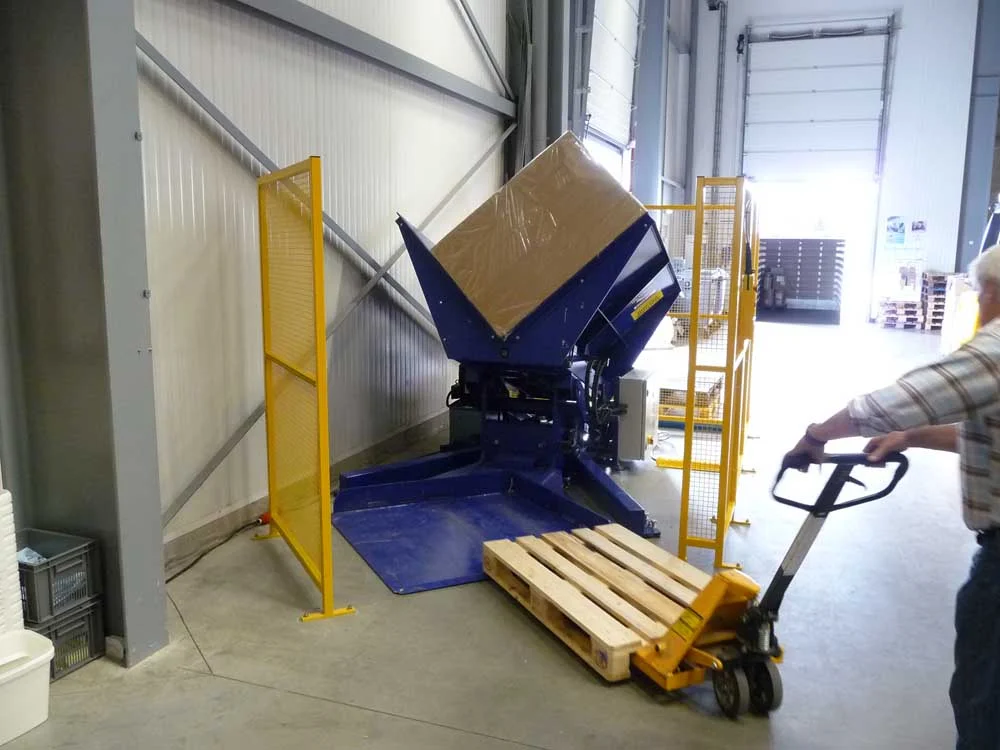Meeting Lower Downtime In Agri-Export Processing Plants Requirements in Argentina with Automated Pallet Exchange
Argentinian agri-export plants operate under intense pressure. You have perishable goods that must be shipped on time. You face tough competition from around the world. Every single delay and every minute of downtime directly cuts into your profits. A simple problem, like a broken pallet or a slow manual exchange, can create a huge bottleneck. This small issue can cause delays that affect your entire supply chain.
Automated pallet exchange systems help meet lower downtime requirements in Argentinian agri-export processing plants by replacing slow and manual processes. These machines transfer a full load from one pallet to another in about 60 seconds. This speed drastically reduces the time a production line is stopped. This increases throughput, lowers the risk of product damage, and makes sure shipments are ready on time.

This solution sounds great, but I know many plant owners worry about the details. They are concerned about the investment and how to implement it correctly. They often ask me, "Vincent, will this truly solve my specific downtime problems?" I understand this hesitation. So, let's break it down. We will look at how these systems directly reduce downtime. We will uncover the hidden costs of manual handling you might not be seeing. And we will discuss how to choose the right machine for your plant.
How does an automated pallet exchange directly reduce downtime?
Your production schedule is perfect. The line is running at full capacity. But then, everything stops at the final step: the pallet exchange. You see a team of workers manually unstacking and restacking boxes. The process is slow. It creates safety risks. This planned stop feels more like an unexpected problem. This scheduled downtime hurts your Overall Equipment Effectiveness (OEE) and eats into your capacity. What if you could almost completely remove this "necessary" stop?
An automated pallet exchange directly reduces downtime by turning the entire pallet transfer process into one quick, mechanical action. Instead of taking a team of workers a long time, the machine usually finishes the job in about one minute. This allows your production and packaging lines to run almost without stopping. This maximizes your output and cuts down on idle time.

The True Impact of a 60-Second Exchange
The most obvious benefit is the raw speed. Let's compare the two processes. A manual exchange requires multiple steps. Workers must unwrap the pallet, lift boxes one by one or in small groups, stack them on the new pallet, and then re-wrap the new load. This can take anywhere from 15 to 30 minutes, depending on the load's complexity and the team's efficiency. An automated system condenses this into a single cycle. The entire load is clamped, moved, and placed on the new pallet in around 60 seconds. This is a time saving of over 95% for this specific task.
This time saving has a ripple effect. A bottleneck at the end of the line can back up the entire process. If pallets are not cleared away quickly, your pallet wrapper, case packer, and even your primary production machines may have to slow down or stop. By making the final step incredibly fast, you ensure the whole line can run at its intended speed. This directly improves your OEE score, which is a key metric for any efficient manufacturing plant. I saw this in my own factory. Improving one small part of the line often created a positive effect everywhere else.
From Unplanned to Predictable Operations
Downtime isn't always planned. Manual handling is a major source of unplanned downtime. A worker could strain their back, leading to an injury and a stop in production. A dropped box could damage products, requiring a cleanup and quality check. These events are unpredictable and disruptive. Automation makes the process consistent and safe. The machine performs the same task, in the same way, every time. This removes the human variable and the associated risks. You can confidently schedule your operations knowing that the pallet exchange will take a predictable amount of time, with almost zero risk of unexpected stops. This stability is critical for meeting the tight shipping deadlines common in the Argentinian agri-export sector.
| Feature | Manual Pallet Exchange | Automated Pallet Exchange |
|---|---|---|
| Average Time | 15-30 minutes | ~60 seconds |
| Labor Requirement | 2-3 workers | 1 operator (monitoring) |
| Risk of Product Damage | High (dropping, crushing) | Very Low (secure clamping) |
| Risk of Worker Injury | High (lifting, repetitive motion) | Very Low (automated process) |
| Process Consistency | Low (depends on workers) | High (machine-controlled) |
| Impact on OEE | Negative (significant planned downtime) | Positive (minimal downtime) |
It is easy to see the cost of labor on your financial statements. But are you looking at the complete picture? What is the real cost of products damaged during clumsy handling? What about the cost of shipments that get rejected because of contaminated or non-compliant wooden pallets? Or the cost of worker compensation claims after an injury? These hidden costs are like slow leaks in a pipe. They quietly drain your profitability, and you might not even notice them until the damage is significant.
The hidden costs of manual pallet handling in Argentinian agri-export plants are much larger than just worker wages. They include major financial losses from product damage during the transfer. They include costs tied to worker injuries and lost workdays. They include lower productivity because of worker fatigue. And they include the risk of having entire shipments rejected if pallets do not meet strict international standards like ISPM 15.

The High Price of Damaged Goods and Contamination
In the agri-export business, product quality is everything. When workers manually unstack and restack heavy boxes, mistakes happen. Packaging gets crushed, and the products inside, like fruits or vegetables, can get bruised. This damage can lead to rejection by your customer. This doesn't just mean a loss of revenue for that shipment; it can also damage your reputation. Automation handles the entire load as a single, stable unit. It uses precise pressure to hold the load securely without causing any damage.
Hygiene is another critical factor. Many Argentinian agri-export plants use internal wooden pallets that may not be suitable for export. The process of moving goods to a clean, food-grade plastic or heat-treated export pallet must be done carefully to avoid contamination. Manual handling increases the risk of dirt or bacteria transferring to the new pallet or the products. An automated pallet exchanger creates a more controlled environment for the transfer. It minimizes human contact and helps ensure your products meet the strict hygiene standards of international markets. This is a simple way to protect your product's integrity.
The Real Cost of Labor and Safety
The cost of labor is not just the hourly wage. You must also consider the costs of training, high employee turnover in physically demanding jobs, and the huge impact of a workplace injury. Repetitive heavy lifting is a leading cause of back injuries. One serious injury can lead to expensive medical bills, worker compensation claims, and lost productivity. You may also need to hire and train a replacement. These costs add up quickly.
Automation removes the physical strain from your employees. The operator of a pallet exchange system simply pushes a button. This creates a safer work environment. A safer workplace leads to higher morale and lower employee turnover. When I started my journey in this industry, I learned that investing in my team's safety was one of the best investments I could make for my business's long-term health.
| Hidden Cost Category | Manual Handling Impact | Automated System Benefit |
|---|---|---|
| Product Damage | High rates of crushed boxes, bruised goods. | Minimal to no damage with secure clamping. |
| Contamination | High risk of cross-contamination. | Controlled transfer, improves hygiene. |
| Worker Injury | Frequent back strains and other injuries. | Eliminates physical lifting, drastically improves safety. |
| Labor Turnover | High turnover due to physically demanding work. | Reduces physical strain, improves job satisfaction. |
| Compliance Risk | Risk of using non-compliant pallets. | Easy and quick switch to ISPM 15 compliant pallets. |
| Productivity Loss | Worker fatigue slows down the process over a shift. | Consistent speed and performance all day. |
How do you choose the right automated pallet exchange system for your needs?
You are now convinced that automation is the best path forward. So, you start looking online for solutions. You quickly see many different types of machines: pallet inverters, pallet changers, pushers, and tippers. The number of options can feel overwhelming. Choosing the wrong machine is an expensive mistake. It could create more problems than it solves. How do you find the perfect fit for your specific operation in Argentina?
To choose the right automated pallet exchange system, you must first carefully analyze your product, your pallet types, and your operational workflow. The most important factors to think about are the weight and stability of your load, the speed you need, the amount of floor space you have, and whether you need to turn the product upside down or just push it from one pallet to the other.

Matching the Machine to the Product
Not all pallet exchange systems are the same. The right choice depends entirely on what you are handling. Let’s look at the main types.
A Pallet Inverter is a machine that clamps the load from the top and bottom, then rotates it a full 180 degrees. The old pallet is now on top and can be easily removed. A new pallet is placed, and the machine rotates back. This method is excellent for stable, boxed goods like bags of grain, cartons of beverages, or other durable items. It's fast and very secure.
A Pallet Changer (or Pusher System) is a different solution. It works by holding the load on three sides and then gently pushing it from the source pallet onto a waiting destination pallet. This is the ideal choice for sensitive, fragile, or unstable loads. Think of trays of fruit, bottled products, or open-top boxes. Because the product is not tilted or inverted, the risk of disturbing the contents is very low.
A Load Tipper is a sort of middle ground. It tilts the entire load to about 95 or 110 degrees, allowing the pallet to slide away. This can be a good option for certain loads and is often more compact than other systems.
Key Questions for Your Supplier
Once you know which type of machine might be best, you need to ask a potential supplier some very specific questions. When I was setting up my own packing machine factory, I learned that the details are everything. A machine that looks good on paper but doesn't fit your reality is worthless. Here is what you need to ask:
- What is the exact cycle time? Get a real number, not just an estimate.
- What are the dimensions (footprint) of the machine? You need to make sure it will fit in your available space.
- What are the power and compressed air requirements? Ensure your plant's infrastructure can support it.
- How does it handle different load sizes and weights? You need a machine that can handle your lightest and your heaviest loads.
- What safety features are included? Look for light curtains, safety fences, and emergency stops. Safety is not optional.
- How much maintenance is required? Ask about daily checks and yearly service needs.
| Machine Type | Best For | Key Feature | Question to Ask |
|---|---|---|---|
| Pallet Inverter | Stable, robust loads (e.g., bags, solid boxes) | 180-degree rotation | "What is the maximum clamping pressure?" |
| Pallet Changer | Sensitive, unstable loads (e.g., bottles, trays) | Gentle push-transfer | "How does it keep the load aligned during transfer?" |
| Load Tipper | Semi-stable loads, limited space | 95-degree tilt | "Is there any risk of the load shifting during the tilt?" |
My Insights
When I began my career as a young engineer on a factory floor, I saw these kinds of problems every day. In the steel industry, where I spent many years, a single minute of downtime on a production line can cost thousands of dollars. We were obsessed with saving every second. That's why when I look at the challenges in an Argentinian agri-export plant, I don't just see a packaging issue. I see a fundamental manufacturing problem that needs a smart solution.
A business leader like Javier Morales, running a large steel mill in Mexico, understands this perfectly. His challenges—like dealing with aging equipment, high energy costs, and the constant pressure for more uptime—are universal in heavy industry. The answer is never just to buy a new machine. The answer is to find a strategic partner who understands your entire operation. A partner who can help you find a solution that integrates smoothly and delivers a real return on investment.
Whether you are handling giant steel coils or pallets of fresh apples, the core principles of efficiency are exactly the same. You need to streamline your process. You need to reduce the number of times a product is handled manually. You need to eliminate waste in all its forms—wasted time, wasted material, and wasted human effort. And you must invest in technology that gives you a predictable, stable, and safe operation.
The automated pallet exchanger is a perfect example of this philosophy in action. It’s more than just a piece of equipment. It is a strategic tool. It’s a tool to reduce your operational costs, increase your throughput, and improve the safety of your workplace. Ultimately, it’s a tool that helps you boost your bottom line.
My journey from a factory employee to a factory owner taught me so much. It gave me financial independence and the chance to help many clients grow their businesses. Now, my mission with SHJLPACK is to give back. I want to share the knowledge I gained along the way to help you make informed decisions for your business, whether you're in steel, agriculture, or any other industry. This is how we can all grow stronger, together.
Conclusion
Automated pallet exchange is a strategic investment. It directly fights downtime, cuts hidden costs, and secures your place in the competitive Argentinian agri-export market.




